Pgiam/iStock via Getty Images
Investment Thesis
The “fundamentals” of evolving medical technology makes staying current in these fields an intensive, full-time job. That leaves individual investors often excluded from that necessary part of the value analysis.
Instead, competent and experienced full-time employee analysts at big-$ investment “institutions” keep track of those developments while others at the firm integrate the investment industry moving parts into capital-commitments of desired share-holding trades. Then Wall Street Market-Makers take over to find “other side of the trade” balancing partners at other institutions with their own reasons for actions.
In the process risks must be taken and protected against, where predictive markets by their hedging-deal pricing translate expectations into bounds of coming share prices, both to the upside and the down. The market’s subsequent actions put odds on those expectations.
Descriptions Of The Companies With Securities Involved
“Johnson & Johnson, together with its subsidiaries, researches and develops, manufactures, and sells various products in the healthcare field worldwide. It serves general public, retail outlets, retailers, wholesalers, distributors, hospitals, and healthcare professionals directly for prescription use. Its MedTech segment provides electrophysiology products to treat cardiovascular diseases; neurovascular care products to treat hemorrhagic and ischemic stroke; orthopaedics products and other; advanced and general surgery solutions The company was founded in 1886 and is based in New Brunswick, New Jersey.”
Source: Yahoo Finance
Yahoo Finance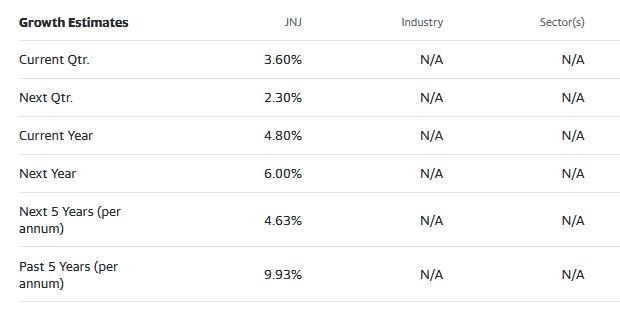
“Novo Nordisk A/S, a healthcare company, engages in the research, development, manufacture, and marketing of pharmaceutical products worldwide. It operates in two segments, Diabetes and Obesity care, and Biopharm. The Diabetes and Obesity care segment provides products in the areas of insulins, GLP-1 and related delivery systems, oral antidiabetic products, obesity, and other chronic diseases. The Biopharmaceuticals segment offers products in the areas of haemophilia, growth disorders, and hormone replacement therapy. The company collaboration agreements with Gilead Sciences, Inc. Novo Nordisk A/S also has a research collaboration with Lumen Bioscience, Inc. to explore strategies for delivering oral biologics for cardiometabolic disease. The company was founded in 1923 and is headquartered in Bagsvaerd, Denmark.”
Source: Yahoo Finance
Yahoo Finance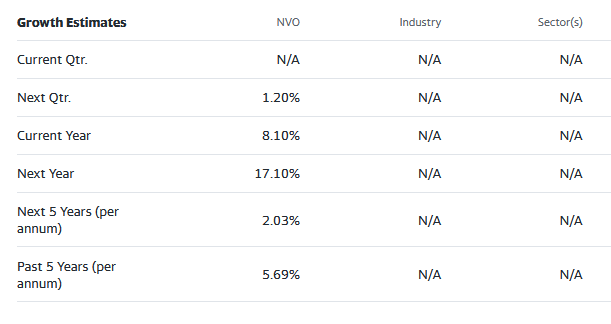
These growth estimates have been made by and are collected from Wall Street analysts to suggest what conventional methodology currently produces. The typical variations across forecast horizons of different time periods illustrate the difficulty of making value comparisons when the forecast horizon is not clearly defined.
Risk And Reward Balances Among Healthcare Providers
Let’s consider selections from an “Opportunity Set” of comparable companies ranging from most to least attractive to examine in one particular area of Healthcare today – longer-term care, often of elderly Among the many active participants are two we have an interest.
One widely owned stock is Johnson & Johnson (NYSE:JNJ). Another is Novo Nordisk A/S (NVO). Here in Figure 1 is how the markets currently appraise their Reward ~ Risk trade-offs, based on behavioral analysis (of what investing systems require to be done, not of emotional investor errors) of actions by Market-Makers [MMs] as they protect their at-risk capital from possible damaging future market-price moves.
Figure 1
blockdesk,com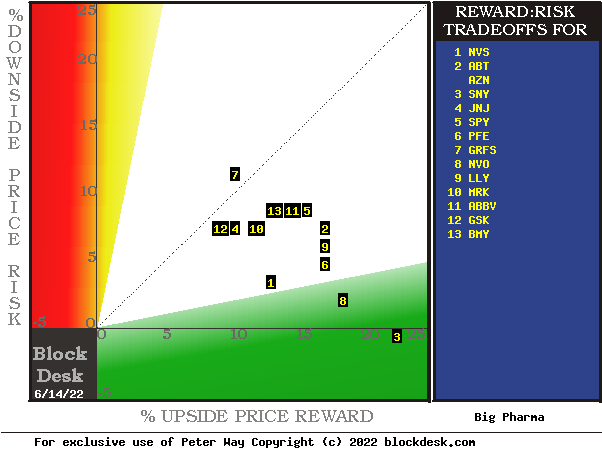
(used with permission)
Their actions are essential to the conduct of irregular large-volume “block trades” which are the frequent movers of stock prices, rather than the continual small-volume traffic of the “investing public” individuals. Upside price rewards are from their potential reward forecasts, measured by the green horizontal scale.
The risk dimension is of actual price drawdown at their most extreme point while being held in previous pursuit of upside rewards similar to the ones currently being seen. They are measured on the red vertical scale.
Both scales are of percent change from zero to 25%. Any stock or ETF whose present risk exposure exceeds its reward prospect will be above the dotted diagonal line. Capital-gain attractive to-buy issues are in the directions down and to the right.
Our principal interest is in JNJ at location [4], high near the diagonal dotted line separating profitable from losing forecast outcomes. Down in the green area of forecast outcomes with five times as much gain as loss is NVO at [8]. A “market index” norm of reward~risk tradeoffs is offered by SPY at [5]. Most appealing by this Figure 1 view is NVO at [8]. The negatives of SNY at [3] are a data processing event.
Comparing Competitive Features Of Big Pharma Stocks
The Figure 1 map provides a good visual comparison of the two most important aspects of every equity investment in the short term. There are other aspects of comparison which this map sometimes does not communicate well, particularly when general market perspectives like those of SPY are involved. Where questions of ‘how likely’ are present, other comparative tables, like Figure 2, may be useful.
Yellow highlighting of the table’s cells emphasize factors important to securities valuations, and the security NVO of most promising of near capital gain as ranked in column [R]. The pink highlighting identifies the less-favored JNJ.
Figure 2
Why Do All This Math?
Figure 2’s purpose is to attempt universally comparable answers, stock by stock, of a) How BIG the prospective price gain payoff may be, b) how LIKELY the payoff will be a profitable experience, c) how SOON it may happen, and d) what price drawdown RISK may be encountered during its holding period.
Readers familiar with our analysis methods after quick examination of Figure 2 may wish to skip to the next section viewing price range forecast trends for JNJ and NVO.
Column headers for Figure 2 define investment-choice preference elements for each row stock whose symbol appears at the left in column [A]. The elements are derived or calculated separately for each stock, based on the specifics of its situation and current-day MM price-range forecasts. Data in red numerals are negative, usually undesirable to “long” holding positions. Table cells with yellow fills are of data for the stocks of principal interest and of all issues at the ranking column, [R]. Cells with pink fills, like column [H] row JNJ, warn of deficiencies from minimum standards. In this case, less than 80% of prior forecasts history at today’s Range Index earning a profit.
The price-range forecast limits of columns [B] and [C] get defined by MM hedging actions to protect firm capital required to be put at risk of price changes from volume trade orders placed by big-$ “institutional” clients.
[E] measures potential upside risks for MM short positions created to fill such orders, and reward potentials for the buy-side positions so created. Prior forecasts like the present provide a history of relevant price draw-down risks for buyers. The most severe ones actually encountered are in [F], during holding periods in effort to reach [E] gains. Those are where buyers are emotionally most likely to accept losses.
The Range Index [G] tells where today’s price lies relative to the MM community’s forecast of upper and lower limits of coming prices. Its numeric is the percentage proportion of the full low to high forecast seen below the current market price.
[H] tells what proportion of the [L] sample of prior like-balance forecasts have earned gains by either having price reach its [B] target or be above its [D] entry cost at the end of a 3-month max-patience holding period limit. [I] gives the net gains-losses of those [L] experiences.
What makes NOV most attractive in the group at this point in time is its ability to produce earnings most consistently at its present operating balance between share price risk and reward, the Range Index [G]. Credibility of the [E] upside prospect as evidenced in the [I] payoff is shown in [N].
Further, Reward~Risk tradeoffs involve using the [H] odds for gains with the 100 – H loss odds as weights for N-conditioned [E] and for [F], for a combined-return score [Q]. The typical position holding period [J] on [Q] provides a figure of merit [fom] ranking measure [R] useful in portfolio position preferencing. Figure 2 is row-ranked on [R] among alternative candidate securities, with NOV in top rank, below the deficient JNJ.
Along with the candidate-specific stocks these selection considerations are provided for the averages of some 3100 stocks for which MM price-range forecasts are available today, and 20 of the best-ranked (by fom) of those forecasts, as well as the forecast for S&P 500 Index ETF (SPY) as an equity-market proxy.
As shown in column [T] of figure 2, those levels vary significantly between stocks. What matters is the net gain between investment gains and losses actually achieved following the forecasts, shown in column [I]. The Win Odds of [H] tells what proportion of the Sample RIs of each stock were profitable. Odds below 80% often have proven to lack reliability.
Recent Forecast Trends of Primary Subjects
Figure 3
(used with permission)
Figure 4
Many investors confuse any picture of time-repeating stock prices with typical “technical analysis charts” of past stock price history. Instead, Figure 3’s vertical lines are a daily-updated visual record of price range forecast limits expected in the coming few weeks and months. The heavy dot in each vertical is the stock’s closing price on the day the forecast was made.
That market price point makes an explicit definition of the price reward and risk exposure expectations which were held by market participants at the time, with a visual display of the vertical balance between risk and reward.
The measure of that balance is the Range Index (RI). Here in NVO, only 16% of the full forecast range of $102 to $125 lies between the current price of $106 and $102. With today’s RI there is five times as much upside price change in prospect as downside. All 34 of the prior forecasts like today’s RI balance have been profitable. The expected potential of +18% upsides became accomplishments of +11.6% gains in 39 market days, or about two months. So history’s advantage could be repeated six times a year, which compounds into a CAGR of +105% which compares to only a 3% dividend yield on JNJ.
Also, please note the smaller pictures in Figures 3 and 4. They show the past 5-year distribution of Range Indexes, with the current level visually marked. For JNJ, the dominant history has been evaluations with higher prices and Range Indexes.
Conclusion
Based on direct comparisons with JNJ and other Big Pharma companies, there are several clear reasons to prefer a capital-gain seeking buy in Novo Nordisk A/S (NVO).
An active investment response would be to swap capital out of JNJ into NVO, anywhere the principal is sheltered from taxation by its portfolio circumstances.



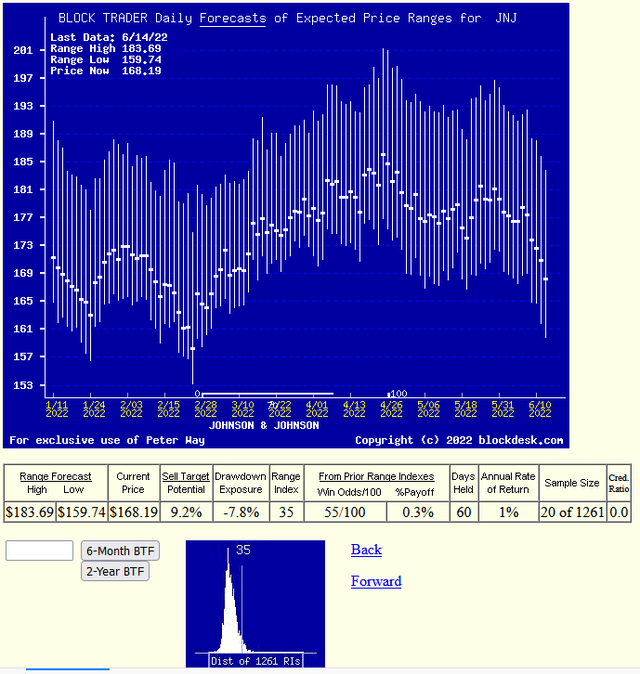
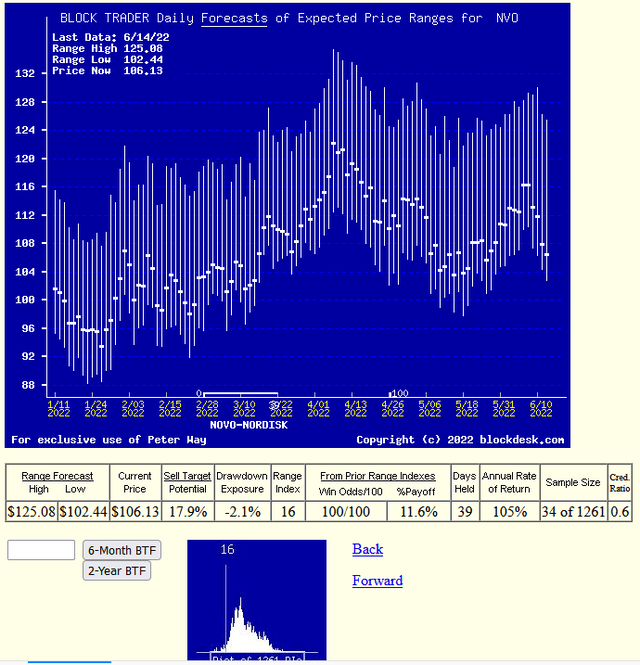
Be the first to comment